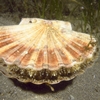General Description
The shells of this species have a rounded ovate shape which distinguishes them from other Victorian tellins. The exterior sculpture is of intersecting fine radial and concentric lines (striae) giving it a decussated appearance. Shells are white. Shell up to 5 cm across.
Biology
Like other bivalves in this family group, this species is a deposit feeder, feeding off small pieces of decaying seaweed and animals that settle on the sea floor.
Habitat
In sand or mud areas.
Soft substrates
Distribution guide
Most states of Australia.
Species Group
Sea snails and shells › Bivalves
Depth
Water Column
Max Size
5 cm
Diet
Organic matter
Commercial Species
No
Conservation Status
- DSE Advisory List : Not listed
- EPBC Act 1999 : Not listed
- IUCN Red List : Not listed






